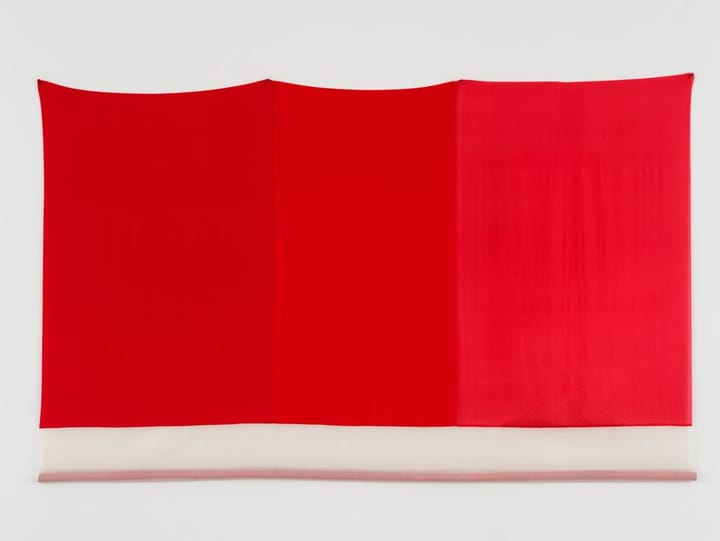Fluid Motion: The Perfect Mix of Art and Science in Houston
An exhibit currently shown in both the Houston Museum of Natural Science and the Nicole Longnecker Gallery is a compelling mixture of art and science

Abstraction is an artistic concept that is easy to dismiss from a “common sense” standpoint. If your idea of beauty is representational literalism, then a swirling mass of color and shapes is just a mess.
However, abstraction is just as representational as a conventional portrait or landscape, so long as you know what it is trying to represent. Nothing highlights that better than the latest incarnation of the Traveling Gallery of Fluid Motion, currently being shown in both the Houston Museum of Natural Science and the Nicole Longnecker Gallery. It is a compelling mixture of art and science that redefines the chaotic aspects of nature into visual representation, sometimes with startling results.
This version of Fluid Motion is called “The Coexistence of Order and Chaos.” The focus is scientific work regarding movements in systems, particularly through air and water. What starts out as attempts to map data for analysis and study is framed as artistic works, a daring transgression for people convinced science and art stay on opposite sides of the playground.
In the Longnecker portion of Fluid Motion is a strange, white sculpture. It looks vaguely like an alien spaceship, something that might have been built by a species that has no concept of human aesthetics. It’s kind of hideous.
At least, until you understand what it actually is. The piece is called “Volute 1: Au Clair de la Lune, 2016.” It’s a 3D printed speech cloud, the literal shape of human language as it leaves the mouth and enters the air. The cloud was generated by scientists at the Georgia Institute of Technology, Auburn University, and New York University. The reason it’s called “Au Clair de Lune” is because those were the first words ever mechanically recorded for replay in 1860, the literal birth of capturing sound as art.
Take a second and think about what this conventionally ugly sculpture represents. It’s the culmination of scientific advancement from the nineteenth century phonautograph to the twenty-first century 3D printer. When Édouard-Léon Scott de Martinville said his phrase, he could imagine that he could preserve the act of speaking but never could have guessed it would be possible to frame his words visually as they expanded through the invisible air.
It’s such a lovely phrase, as well. “In the light of the moon” in English, and the name of Claude Debussy’s most famous piano piece. If this scientifically-generated lump of white material is how air molecules experience our words, what does a declaration of love look like? An opera? A Shakespearean monologue? Or the theme song from Doctor Who?
All great art makes you look at something in a new light, and that is the glory of Fluid Motion. Pieces chart the movements of tornadoes, how water flows around fish, or the way particles form snakelike trails on heated surfaces.
There is this small section in the museum portion that explores how turbulence acts in pipes. This is important science, impactful on everything from blood flow to the oil industry. It’s also really, really, hard to study. “Turbulent Pipe Flow at High Reynolds Number, 2021” opens its description with the acknowledgement that no known instrument is currently capable of measuring turbulence inside a pipe. We can’t even make the pipes translucent to observer it. Well, we can, but the warping effects of the transparent material makes observation useless.
The answer is 3D computer modeling, which is done using a non-dimensional number called a Reynolds number. The ones on display for Fluid Motion were done by Alessandro Ceci, Sergio Pirozzoli, Joshua Romera, Massimliano Fatica, Robert Verzicco, and Paolo Orlandi. By using a Reynolds number of 6,000 in their model, they turn liquid flow in a pipe into a maelstrom of movement and activity.
On the one hand, yes, this could be intrinsic in understanding circulatory diseases or transporting oil in a pipeline. It’s also, on its own, a piece of art that reveals abstraction to just be representation of forces in motion. There is little fundamental difference between how Jackson Pollock’s paint dribbles capture his mood in flux and how the computer model reveals the same in a natural force. It’s a kind of a landscape painting, as long as you’re willing to see it that way.
Fluid Motion is full of interesting science and the ways that researchers try to understand the apparent chaos of systems. Grasping for that understanding has created an equally fascinating type of art, one built of algorithms and binary code. Mapping abstraction this way is no less beautiful than with paint or clay, and in this case, it also helps us contextualize chaos in ways he might never otherwise be able to do.
Fluid Motion: The Coexistence of Order and Chaos is on display at the Houston Museum of Natural Science (free with general admission) and the Nicole Longnecker Gallery (free) through January 25, 2026.



Comments ()